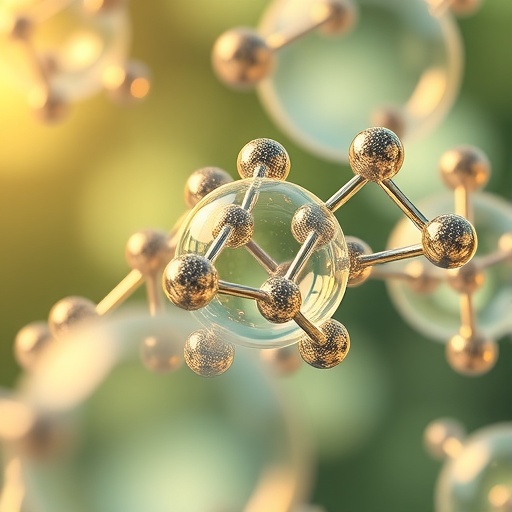In a groundbreaking study emerging from Ohio State University, chemists have unveiled a pioneering framework that advances our understanding of carbon monoxide’s adhesion to catalyst surfaces during the conversion of carbon dioxide. This adhesion, quantified as carbon monoxide (CO) adsorption energy, represents a crucial parameter that directly influences the selectivity and efficiency of electrochemical reactions that transform carbon dioxide, a notoriously stable and inert molecule, into valuable chemical fuels.
For decades, scientists have grappled with accurately measuring the binding strength of CO under actual reaction conditions. While computational models have predicted varying adsorption energies, validating these predictions has been notoriously challenging due to the complex interplay of factors such as catalyst composition, operational voltage, and microscopic surface morphology. The new study utilizes an advanced yet experimentally accessible electroanalytical technique that captures the dynamic and multifaceted nature of CO adsorption in situ, providing unprecedented insight into reaction kinetics and mechanistic pathways.
The implications of this work are far-reaching for the realm of sustainable chemistry. By elucidating the fundamental parameters governing CO adsorption, researchers pave the way toward designing catalysts with finely tuned surface properties that optimize the conversion of CO2 into chemically rich fuels like methanol and ethanol. These liquid fuels are highly sought after for their potential to integrate seamlessly into existing energy infrastructures, offering a cleaner alternative to fossil fuels and closing the carbon loop.
Zhihao Cui, lead author and postdoctoral fellow in the Department of Chemistry at Ohio State, emphasizes that this approach bridges a critical divide between theoretical predictions and experimental validations. The technique not only allows researchers to measure CO binding energies in real-time but also provides a kinetic framework that guides rational catalyst design. “Our method demystifies the adsorption process, enabling the strategic manipulation of catalyst surfaces to enhance the efficiency and selectivity of CO2 electroreduction,” Cui explains.
Published recently in the prestigious journal Nature Catalysis, the study exploits a combination of electrochemical kinetic analysis and surface characterization techniques, exploring how materials such as gold and copper interact with CO. Intriguingly, while both metals exhibit similar CO binding strengths, only copper facilitates the formation of multi-carbon products through CO2 reduction. This counterintuitive finding challenges previous assumptions and highlights the complexity of adsorption phenomena influenced by subtle electronic and structural factors on catalyst surfaces.
Anne Co, senior author and professor of chemistry and biochemistry at Ohio State, notes the inherent challenge posed by the stability of CO2 molecules. “Breaking down carbon dioxide requires overcoming significant energy barriers, often necessitating multiple sequential reaction steps,” she says. The team’s new measurement framework helps illuminate these sequential steps by quantitatively tracking CO intermediates, which are often pivotal in steering product distribution toward desirable hydrocarbons and oxygenates.
The broader significance of this research extends to its practical implementation. Unlike many analytical techniques that demand costly and esoteric instrumentation, the method introduced by Cui and colleagues relies on widely available electroanalytical tools. This accessibility ensures that laboratories worldwide can readily adopt the technique to screen and optimize a diverse array of catalytic materials, accelerating global efforts in developing carbon-neutral fuel technologies.
Another critical aspect of this study is its kinetic approach that evaluates how applied potential influences CO adsorption free energies. The research reveals that adsorption strength is modulated not merely by the catalyst’s identity but also by the electrochemical environment, including voltage and localized surface structure. This nuanced understanding prompts a shift away from static interpretations of catalyst behavior toward dynamic models that better reflect operational conditions.
Looking forward, the research team acknowledges the need to refine and expand their model. While the current framework captures essential elements governing CO adsorption kinetics, the chemical reactions at electrochemical interfaces are inherently complex, involving multi-scale phenomena from atomic interactions to macroscale transport processes. Future work aims to integrate these layers, enabling more comprehensive predictive capabilities that could unlock even higher-performance catalysts.
Additionally, the study underscores an inspiring lesson for the scientific community: even relatively straightforward experimental techniques, when applied innovatively, can yield transformative insights. Cui highlights this sentiment by encouraging researchers to pursue novel ideas that challenge conventional limitations. “What was once thought impractical to measure can be brought within reach given the right conceptual approach,” he affirms.
Ohio State’s research team, including co-authors Kassidy Aztergo and Jiseon Hwang, conducted this work with funding support from the National Science Foundation. Their collaborative effort exemplifies the intersection of fundamental chemistry, materials science, and environmental sustainability, reinforcing the global imperative to develop renewable energy solutions.
As the world grapples with climate change and escalating carbon emissions, advances like this offer tangible hope. By uncovering the mechanistic intricacies of CO adsorption, scientists edge closer to transforming captured carbon dioxide from an atmospheric pollutant into a resource for clean energy, fueling a paradigm shift toward a sustainable and circular carbon economy.
Subject of Research: Chemistry, Electrochemistry, CO2 Electroreduction, Catalyst Surface Interactions
Article Title: Determining CO adsorption free energies on CO2 electroreduction active sites through kinetic analysis
News Publication Date: 23-Oct-2025
Web References:
References:
- Cui, Z., Co, A., Aztergo, K., Hwang, J. (2025). Determining CO adsorption free energies on CO2 electroreduction active sites through kinetic analysis. Nature Catalysis. https://doi.org/10.1038/s41929-025-01427-1
Keywords
Chemistry, Electrochemistry, Electrochemical reactions, Electrocatalysis, Electrochemical energy, Chemical compounds, Carbon compounds, Carbon dioxide, Anthropogenic carbon dioxide




